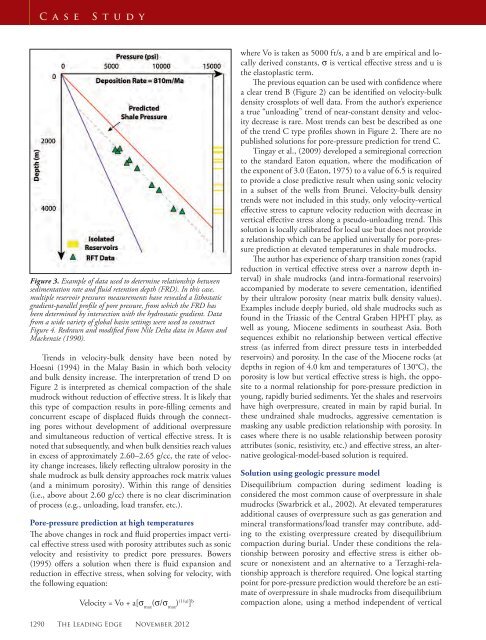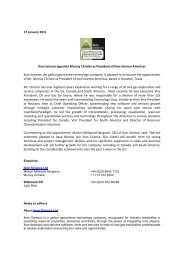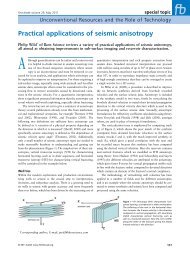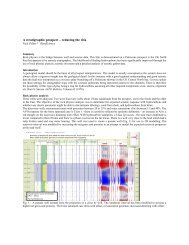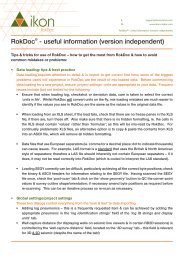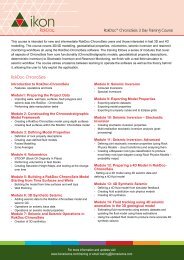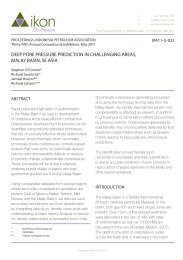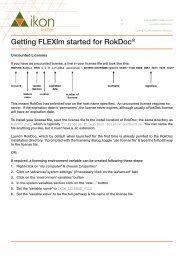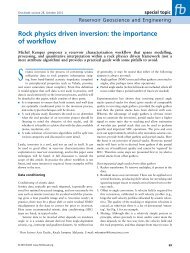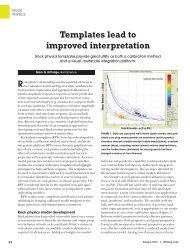Pore Pressure Prediction TLE Nov 2012 Swarbrick - Ikon Science
Pore Pressure Prediction TLE Nov 2012 Swarbrick - Ikon Science
Pore Pressure Prediction TLE Nov 2012 Swarbrick - Ikon Science
- No tags were found...
Create successful ePaper yourself
Turn your PDF publications into a flip-book with our unique Google optimized e-Paper software.
Case StudyFigure 3. Example of data used to determine relationship betweensedimentation rate and fluid retention depth (FRD). In this case,multiple reservoir pressures measurements have revealed a lithostaticgradient-parallel profile of pore pressure, from which the FRD hasbeen determined by intersection with the hydrostatic gradient. Datafrom a wide variety of global basin settings were used to constructFigure 4. Redrawn and modified from Nile Delta data in Mann andMackenzie (1990).Trends in velocity-bulk density have been noted byHoesni (1994) in the Malay Basin in which both velocityand bulk density increase. The interpretation of trend D onFigure 2 is interpreted as chemical compaction of the shalemudrock without reduction of effective stress. It is likely thatthis type of compaction results in pore-filling cements andconcurrent escape of displaced fluids through the connectingpores without development of additional overpressureand simultaneous reduction of vertical effective stress. It isnoted that subsequently, and when bulk densities reach valuesin excess of approximately 2.60–2.65 g/cc, the rate of velocitychange increases, likely reflecting ultralow porosity in theshale mudrock as bulk density approaches rock matrix values(and a minimum porosity). Within this range of densities(i.e., above about 2.60 g/cc) there is no clear discriminationof process (e.g., unloading, load transfer, etc.).<strong>Pore</strong>-pressure prediction at high temperaturesThe above changes in rock and fluid properties impact verticaleffective stress used with porosity attributes such as sonicvelocity and resistivity to predict pore pressures. Bowers(1995) offers a solution when there is fluid expansion andreduction in effective stress, when solving for velocity, withthe following equation:Velocity = Vo + a[σ max(σ/σ max) (1/u) ] bwhere Vo is taken as 5000 ft/s, a and b are empirical and locallyderived constants, σ is vertical effective stress and u isthe elastoplastic term.The previous equation can be used with confidence wherea clear trend B (Figure 2) can be identified on velocity-bulkdensity crossplots of well data. From the author’s experiencea true “unloading” trend of near-constant density and velocitydecrease is rare. Most trends can best be described as oneof the trend C type profiles shown in Figure 2. There are nopublished solutions for pore-pressure prediction for trend C.Tingay et al., (2009) developed a semiregional correctionto the standard Eaton equation, where the modification ofthe exponent of 3.0 (Eaton, 1975) to a value of 6.5 is requiredto provide a close predictive result when using sonic velocityin a subset of the wells from Brunei. Velocity-bulk densitytrends were not included in this study, only velocity-verticaleffective stress to capture velocity reduction with decrease invertical effective stress along a pseudo-unloading trend. Thissolution is locally calibrated for local use but does not providea relationship which can be applied universally for pore-pressureprediction at elevated temperatures in shale mudrocks.The author has experience of sharp transition zones (rapidreduction in vertical effective stress over a narrow depth interval)in shale mudrocks (and intra-formational reservoirs)accompanied by moderate to severe cementation, identifiedby their ultralow porosity (near matrix bulk density values).Examples include deeply buried, old shale mudrocks such asfound in the Triassic of the Central Graben HPHT play, aswell as young, Miocene sediments in southeast Asia. Bothsequences exhibit no relationship between vertical effectivestress (as inferred from direct pressure tests in interbeddedreservoirs) and porosity. In the case of the Miocene rocks (atdepths in region of 4.0 km and temperatures of 130°C), theporosity is low but vertical effective stress is high, the oppositeto a normal relationship for pore-pressure prediction inyoung, rapidly buried sediments. Yet the shales and reservoirshave high overpressure, created in main by rapid burial. Inthese undrained shale mudrocks, aggressive cementation ismasking any usable prediction relationship with porosity. Incases where there is no usable relationship between porosityattributes (sonic, resistivity, etc.) and effective stress, an alternativegeological-model-based solution is required.Solution using geologic pressure modelDisequilibrium compaction during sediment loading isconsidered the most common cause of overpressure in shalemudrocks (<strong>Swarbrick</strong> et al., 2002). At elevated temperaturesadditional causes of overpressure such as gas generation andmineral transformations/load transfer may contribute, addingto the existing overpressure created by disequilibriumcompaction during burial. Under these conditions the relationshipbetween porosity and effective stress is either obscureor nonexistent and an alternative to a Terzaghi-relationshipapproach is therefore required. One logical startingpoint for pore-pressure prediction would therefore be an estimateof overpressure in shale mudrocks from disequilibriumcompaction alone, using a method independent of vertical1290 The Leading Edge <strong>Nov</strong>ember <strong>2012</strong>


